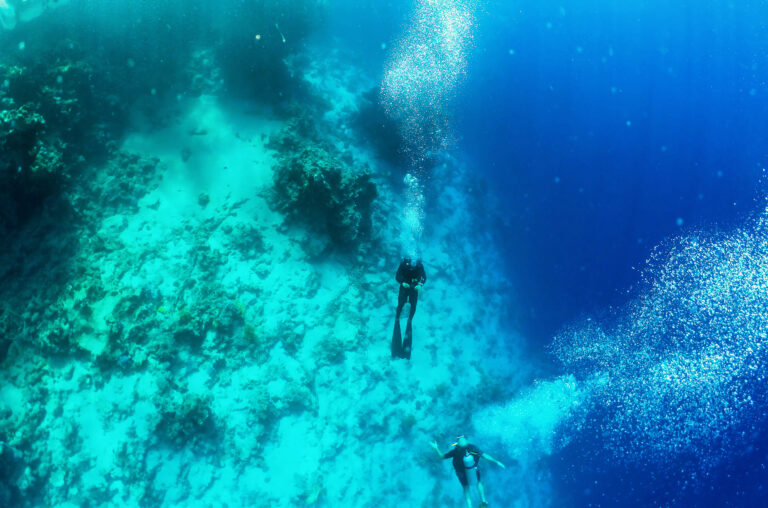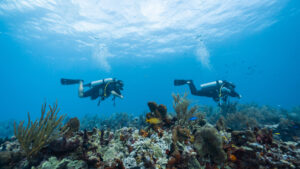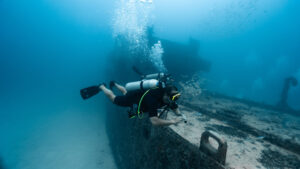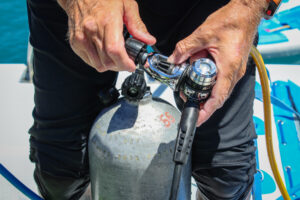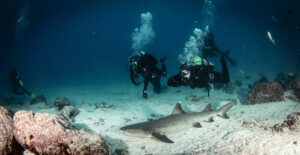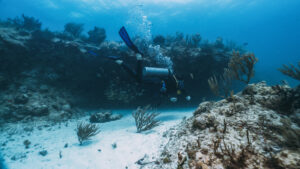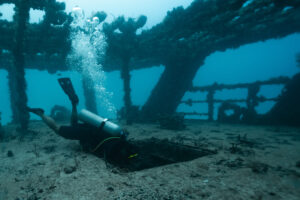What is Partial Pressure?
Partial pressure is a fundamental concept in physics and chemistry, particularly significant in the context of scuba diving. It refers to the pressure exerted by a single type of gas in a mixture of gases. Understanding partial pressure is crucial for divers as it influences how gases are absorbed, transported, and expelled in the human body under varying underwater conditions. This concept helps in comprehending how different gases behave under increased pressures encountered at depth and is essential for ensuring safety and preventing diving-related illnesses.
Basic Principles of Partial Pressure
Partial pressure is defined as the pressure that a gas in a mixture would exert if it alone occupied the entire volume. This concept stems from Dalton’s Law of Partial Pressures, which states that the total pressure exerted by a gas mixture is equal to the sum of the partial pressures of each individual gas. For example, if a mixture contains oxygen, nitrogen, and helium, the total pressure is the sum of the pressures that each of these gases would exert independently.
In the context of diving, understanding partial pressure becomes more complex due to the increased pressures underwater. As a diver descends, the ambient pressure increases by approximately 1 atmosphere (atm) for every 10 meters (32.8 feet) of depth. This increase in pressure affects the partial pressures of the gases the diver breathes, influencing how these gases dissolve and interact with the body’s tissues.
Gases behave differently under varying pressures. At sea level, the partial pressure of oxygen in air is about 0.21 atm. However, at a depth of 30 meters (98.4 feet), the ambient pressure is 4 atm, making the partial pressure of oxygen approximately 0.84 atm if breathing air. This increase can have significant physiological effects, necessitating a clear understanding of partial pressures for safe diving practices.
Importance in Scuba Diving
The role of partial pressure in scuba diving is paramount, primarily because it directly impacts how gases are exchanged in the lungs. When a diver breathes compressed air at depth, the increased partial pressures of oxygen and nitrogen affect how these gases dissolve in the blood. This process is governed by Henry’s Law, which states that the amount of gas dissolved in a liquid is proportional to its partial pressure.
Accurate dive planning requires an understanding of partial pressures to avoid complications such as nitrogen narcosis and decompression sickness. As divers go deeper, the partial pressure of nitrogen increases, leading to a greater absorption of nitrogen into the body’s tissues. If a diver ascends too quickly, the rapid decrease in pressure can cause nitrogen to form bubbles in the tissues and bloodstream, resulting in decompression sickness, also known as “the bends.”
Furthermore, the partial pressure of oxygen must be carefully monitored. While oxygen is essential for life, at high partial pressures, it can become toxic. Hyperoxia, or oxygen toxicity, can occur when the partial pressure of oxygen exceeds safe limits, leading to symptoms such as visual disturbances, convulsions, and in severe cases, loss of consciousness. Divers must be aware of the oxygen levels in their breathing gas to prevent such risks.
Partial Pressure of Oxygen
Oxygen, while vital for survival, can become hazardous at elevated partial pressures. The partial pressure of oxygen (PO2) is a critical factor in dive planning and the use of breathing gases. Safe diving practices dictate maintaining the PO2 within a range that prevents both hypoxia (low oxygen levels) and hyperoxia (high oxygen levels).
At depths beyond 18 meters (59 feet), the increased ambient pressure raises the PO2 of breathing gases. For instance, at 30 meters (98.4 feet), breathing air results in a PO2 of approximately 0.84 atm. Divers typically aim to keep the PO2 below 1.4 atm during normal diving activities and below 1.6 atm during short excursions to minimize the risk of oxygen toxicity.
Hyperoxia can cause various symptoms, collectively referred to as oxygen toxicity. These symptoms include tunnel vision, nausea, twitching, irritability, and in severe cases, seizures. Such seizures underwater can be fatal, making it crucial for divers to adhere to safe PO2 limits. Divers use dive computers and oxygen analyzers to monitor the PO2 of their breathing gas continually, ensuring it remains within the safe range.
Conversely, hypoxia is a concern when the PO2 falls too low, leading to insufficient oxygen for bodily functions. This condition is rare in recreational diving but can occur in technical diving scenarios if gas mixtures are not appropriately managed. Understanding the dynamics of oxygen partial pressure is essential for divers to maintain the delicate balance required for safe diving.
Partial Pressure of Nitrogen
Nitrogen, comprising about 78% of the air we breathe, plays a significant role in diving due to its behavior under pressure. The partial pressure of nitrogen (PN2) increases with depth, leading to physiological effects that divers must manage carefully.
One of the primary concerns with elevated PN2 is nitrogen narcosis, a condition that affects the central nervous system. Commonly referred to as “the rapture of the deep,” nitrogen narcosis can impair a diver’s judgment, motor skills, and perception. The exact onset of symptoms varies among individuals, but it generally becomes noticeable at depths beyond 30 meters (98.4 feet). Divers describe the experience as feeling similar to intoxication, with symptoms ranging from mild euphoria to severe disorientation.
Managing PN2 is also crucial to avoid decompression sickness (DCS). As divers descend, nitrogen dissolves into the body’s tissues at a rate proportional to the increasing PN2. If a diver ascends too quickly, the rapid reduction in pressure can cause the dissolved nitrogen to come out of solution and form bubbles in the tissues and bloodstream. These bubbles can lead to symptoms such as joint pain, dizziness, paralysis, and, in severe cases, death.
To mitigate the risks associated with elevated PN2, divers follow specific ascent protocols and use dive tables or dive computers to plan their dives. These tools help divers determine safe ascent rates and decompression stops, allowing excess nitrogen to be safely eliminated from the body. Understanding the principles of partial pressure and its effect on nitrogen absorption is vital for preventing the potentially severe consequences of decompression sickness.
Partial Pressure and Alternative Breathing Mixes
In addition to standard air, divers often use alternative breathing mixes such as enriched air nitrox, heliox, and trimix to manage the effects of partial pressures at depth. Each of these mixtures has specific applications and benefits, depending on the diving conditions and objectives.
Enriched air nitrox (EANx) contains a higher percentage of oxygen and a lower percentage of nitrogen compared to regular air. Common mixtures include 32% or 36% oxygen. The increased oxygen content reduces the partial pressure of nitrogen, thereby lowering the risk of nitrogen narcosis and decompression sickness. However, the higher PO2 requires careful monitoring to avoid oxygen toxicity, particularly at greater depths.
Heliox, a mixture of helium and oxygen, is used primarily in deep commercial and technical diving. Helium is an inert gas that does not cause narcosis, making it ideal for deep dives. By replacing nitrogen with helium, divers can avoid the narcotic effects and reduce the risk of decompression sickness. However, heliox requires precise planning and gas management due to the high cost of helium and the need for specialized equipment.
Trimix is another alternative breathing gas that includes oxygen, nitrogen, and helium. This mixture is used for very deep dives, where both nitrogen narcosis and oxygen toxicity become significant concerns. Trimix allows divers to balance the partial pressures of these gases, maintaining safe and manageable levels for extended deep diving operations. The precise composition of trimix can be adjusted based on the specific depth and duration of the dive.
Understanding the use and implications of these alternative breathing mixes is crucial for advanced divers. Proper training and equipment are necessary to handle the complexities associated with managing partial pressures in these gas mixtures, ensuring safe and effective diving practices.
Advanced Considerations
For professional divers and those engaged in extreme depth diving, the impact of partial pressures becomes even more pronounced. As divers go deeper, the physiological effects of increased gas partial pressures require careful management and advanced techniques.
At extreme depths, beyond recreational diving limits, the partial pressure of nitrogen and oxygen can reach levels that pose significant risks. The effects of high PN2 and PO2 must be mitigated through the use of specialized gas mixtures, strict dive protocols, and advanced equipment. Divers operating in these environments often rely on heliox or trimix to maintain safe partial pressures and avoid the severe consequences of nitrogen narcosis and oxygen toxicity.
Long-term health considerations are also a concern for professional divers. Chronic exposure to elevated partial pressures, particularly in commercial diving operations, can lead to long-term health issues such as dysbaric osteonecrosis, a condition where bone tissue dies due to inadequate blood supply, often caused by repeated decompression. Regular medical monitoring and adherence to safe diving practices are essential to minimize these risks.
Recent research and advancements in dive medicine continue to improve our understanding of partial pressures and their effects. Studies on gas kinetics, decompression models, and the development of more sophisticated dive computers have enhanced the safety and efficiency of diving operations. Ongoing research aims to refine these models and develop new technologies that better predict and manage the effects of partial pressures on the human body.
Key Takeaways
Understanding partial pressure is essential for safe and effective scuba diving. It influences how gases are absorbed and released in the body, impacting diver safety and performance. Knowledge of partial pressures helps in managing risks associated with oxygen toxicity, nitrogen narcosis, and decompression sickness. Utilizing alternative breathing gases like nitrox, heliox, and trimix allows divers to optimize partial pressures for various diving conditions. Advanced divers and professionals must consider the long-term health effects and utilize the latest research and technology to ensure safe diving practices.

